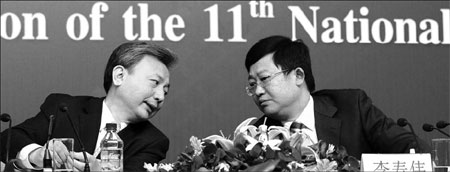Legal Special: Amendments show China on path toward rule of law
By Zhang Yi (China Daily) Updated: 2012-11-12 07:58
|
Lang Sheng (left), deputy director of the Commission of Legislative Affairs under the Standing Committee of the National People's Congress, exchanges opinions with his colleague Li Shouwei at a press conference on the new amendments to the Criminal Procedure Law in Beijing in March. Photos Provided To China Daily |
Among all sectors of the law, criminal procedure is the one most related to the protection of human rights. Like many other countries, China regards it as part of the basic legal framework, and the Criminal Procedure Law is even called "the little Constitution".
Before 1979, China had few legal rules, let alone a codified law concerning criminal procedure because of the special political, economic and social conditions at the time.
After the law was passed in 1979, China's criminal procedure system entered a new era of rule of law.
China has made great economic and social progress since 1979. Correspondingly, China's criminal procedure system has gone through reforms. The lawmakers amended the law in 1996 and again in March this year, both times attracting great attention from around the world.
While feedback has mostly been positive, some people seem only to be evaluating the law with an eye toward protecting human rights. This is a view that is not in line with the law's function and role, nor is it true to the goals and principles of either amendment.
The commonly accepted view in China is that criminal procedure plays two roles - to punish crimes and to protect human rights. China should construct a system of criminal procedures that satisfies the requirements of fairness, effectiveness and responsibility.
To this end, the law and its amendments aim to maintain a good balance between the two roles in a bid to better solve the pressing problems in judicial practices, which may vary from time to time.
Only by integrating the two angles, can we correctly look into the country's efforts to perfect its criminal procedure system.
China first made the criminal procedure law in 1979, a time when the "cultural revolution" (1966-76) had just ended and the reform and opening-up policies were only beginning.
Against such a backdrop, the width and depth of the new legislation in 1979 was unavoidably limited by its historical background.
That law had 164 articles and placed emphasis on the punishment of crimes.
To keep a balance between the two roles, the first big amendments to the law came in 1996. The amendments added or reformed a total of 110 articles in the criminal procedure code, raising the overall number of articles to 225.
The amendments in 1996 obviously strengthened human rights protection. It abolished the rule of exemption from prosecution as well as the system of sheltered inspection.
It reformed models for court trials, replacing the inquisitorial trial with an adversarial process. The new code adopted the rule of presumption of innocence, reformed the defense system, allowed lawyers to be involved in the investigative stage and established a legal aid system.
New social problems have become exposed with the ongoing transformation of society, posing new challenges in the 16 years that have passed since the 1996 amendments.
The progress of the construction of the nation's legal framework and the growing legal awareness among the common people have created higher requirements for the state in its efforts to safeguard judicial justice and protect citizens' rights.
New round of reforms
A second round of amendments to the code of criminal procedure was proposed in 2003, and nearly 10 years passed before a revised law was released in March 2012, which consists of 290 articles and involving 145 articles revised.
The new amendments can be summed up in eight aspects as follows:
Inclusion of "respect for and a guarantee of human rights" into the law, which marks the first time that Chinese lawmakers have written this Constitutional principle into statutory law. It indicates that this principle has a supreme position in China's criminal procedure system, and it will have far-reaching influences on China in terms of protecting human rights.
Improvement in evidence system. Two breakthrough rules were established - requirements for witnesses' presence at trial and the protection of witnesses as well as protection against self-incrimination and the exclusion of illegally obtained evidence - to address such issues as extortion of confessions by torture, severe violations of human rights and low presence rate of witnesses in court.
Improvement in coercive measures system. It sets out clear conditions for arrest and prosecutorial procedures for the approval of arrest, clarifies applicable conditions for residential surveillance and strictly limits exceptions of non-notice of families in the case of coercions.
Improvement in defense system, a core of the modern criminal procedures to guarantee the rights of suspects and defendants.
According to the revision, suspects can hire attorneys at the first interrogation or coercive actions by criminal investigative organs. Detention centers should arrange meetings with suspects at the request of defense attorneys unless otherwise expressly stated in laws.
It expands defense attorneys' rights in consulting case files and increases their vocational safety by excluding the investigative organ handling their clients' cases from getting involved when they are suspected of an offense for improper performance of their duties as legal counsel.
It also confirms the right of defense attorneys to confidentiality for their clients' information involved in cases and expands the scope of legal aid.
Improvement in investigative measures regulations. Whether and how investigative organs can carry out investigative measures are questions of vital importance to solving crimes and protecting human rights.
The revised law enriches means of investigation, such as the employment of technical detection measures and the extraction of biological information, including blood and fingerprints. It also increases the strictness of investigative procedures.
Improvement in trial procedures. The law expands the application of summary procedures to more cases. It also enhances pre-trial and sentencing procedures to improve the efficiency of lower courts.
The new amendments clarify the scope of second trials, regulates the remanding process to avoid repetitive retrials or delay in case settlement and enhance the principle that lodging an appeal will not invite severe penalty if no new crimes are verified. Supplementary civil proceedings and procedures for reviewing death sentences, as well as trial supervision have also been improved in the revised law.
Improvement in enforcement. The law provides further regulation about enforcement, with an emphasis on temporary reprieves from jail sentences for medical reasons and a community correction system.
Special procedures are added to fill a void in the law. They include procedures for juvenile criminal cases, reconciliation in certain cases of public prosecution, confiscation of illegal gains in cases where suspects or defendants have escaped or are dead, and compulsory medical treatment of the mentally ill who have committed violence and continue to endanger the public yet are exempted from criminal liability after identification under statutory procedures.
The progress in the legal system is a gradual process of development. Despite potential shortcomings due to influence by many factors, the new law, as a crystallization of the wisdom and efforts of so many people, fits the national conditions of modern China best.
Objectively, the law represents the country's great progress in systemic improvements and human rights protection through better procedural justice. Simultaneously, the evolving law enables authorities to effectively crack down on crimes, which leads to better social order. The law signifies that China's code of criminal procedure is more mature than before.
The author is director-general of International Legal Cooperation Center of the Ministry of Justice.
For China Daily
(China Daily 11/12/2012 page4)
- Election methods of CPC National Congress approved
- Sound bites from CPC congress
- Foreign politicians, parties, organizations congratulate CPC on national congress
- World party leaders congratulate China on CPC congress
- Intl community lauds Hu's report at CPC congress
- Hu urges CPC to implement essence of the congress
- Beijing urges probe in attack on peacekeepers
- Xi calls for restraint, dialogue
- Plain-packaging push for tobacco products
- Crowds take shine off Disneyland desires
- Mitsubishi settles with Chinese slave laborers
- Premier Li calls for passion in S&T innovation
- China to check halal food
- Action plan targets soil pollution
- Sexually abusive guardians must lose rights, top court reiterates
- Xi, Li see science as key to future









